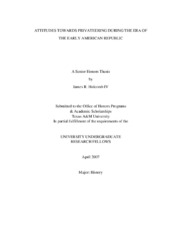| dc.description.abstract | Lacking sufficient funds to build and maintain a sizeable navy, the young United States was forced to employ privateers as a “stop-gap navy” in its struggles against stronger sea powers during the War for Independence, the Quasi War, and the War of 1812. Many American leaders opposed privateering on moral grounds, but felt compelled to employ it. Merchants and seamen were generally more supportive, wither because their usual employment, fishing and peaceful commerce, was denied them when enemies hovered outside American ports and began seizing American ships, or because privateering offered the prospect of quick and large profits. Sailors preferred service in privateers to enlisting in the navy because discipline tended to be less rigorous in privateers than in warships, privateers appeared safer since their captains generally tried to avoid combat with enemy men of war, and privateers offered the prospect of more prize money from the sale of captured ships. Officers in the Continental and United States Navy usually opposed privateering because privateers competed with them for recruits and for naval stores to fit their ships out for sea. Though controversial, it cannot be denied that privateering proved effective. The attacks launched by the private vessels on British and French commerce forced those governments to assign naval forces to protect their shipping. At home, privateering brought a level of prosperity to several American seaports that those communities had not experienced before. Despite its development of a regular navy during the nation’s first half century of independence, the United States continued to employ privateering as an integral part of its defense policy, attitudes toward the practice remained the same, merchants eagerly invested in privateering expeditions, and sailors viewed it as an attractive alternative to service in the regular Navy. | en |


